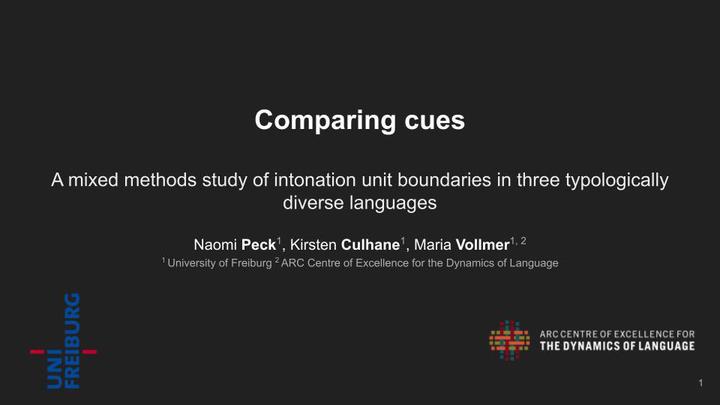Comparing cues
A mixed methods study of intonation unit boundaries in three typologically diverse languages

Abstract
In this presentation, we compare intonational boundary cues in three understudied languages which have three distinct typological profiles - Kera’a (Tibeto-Burman, NE India), which has lexical tone and possibly stress, Waima’a (Austronesian, Timor-Leste), which has no lexical tone or stress, and Warlpiri (Pama-Nyungan, Northern Australia), which has lexical stress and no tone. We take a mixed methods approach to investigate which cues are the most salient, which cues co-occur most frequently, and which factors motivate cue choices. The relative importance of intonational boundary cues has been said to vary on a language- specific basis (Izre’el and Mettouchi 2015, 23), and even the most common cues are realised differently across languages (Himmelmann et al. 2018, 239). We hypothesise, firstly, that speakers of each selected language will differ in what cues they use most frequently and secondly, that the choice of cues will be affected by the information structure of an utterance, as well as the phonological and intonational profile of each language. Recent work by Himmelmann et al. (2018) argues for the universality of intonation unit boundary cues, like pauses, pitch resets, final lengthening and initial rushes. The authors also note the use of less systematic language-specific boundary cues such as creaky voice and unit-initial glottal stops to reinforce the perception of prosodic boundaries (also see Wagner and Watson 2010). Using naturalistic field data from Kera’a, Waima’a and Warlpiri, we segmented our data into intonation units and then annotated each one in Praat for the afore-mentioned phenomena. We also annotate for other phenomena we find in these languages, such as tonal parallelism and final devoicing. Our text selection is controlled for speaker and genre effects, as these could affect cue choices. Our initial results show intra-language diversity in how intonation unit boundary cues are employed. In each language, speakers use different strategies depending on genre. For example, we find differences between procedural and narrative texts. We also observe information structural effects on cue choice, such as the prosodic encoding of new versus old information. Our initial results also demonstrate inter-language diversity in how speakers of each language encode intonation unit boundaries differently, even if the chosen cue is the same. Our data support the claim that pitch reset and pauses are the most important boundary cues, but we find that these cues differ as to their relative importance. Furthermore, we contend that creaky voice is a more consistent boundary cue than the literature suggests. Additionally, traditional concepts of anacrusis and final lengthening proved insufficient for annotating our data, as speakers also make use of final rushes and initial lengthening. We suggest that the cross-linguistic diversity we observe may be linked to the specific typological profiles of each language, indicating a relationship between phonological and intonational inventories.